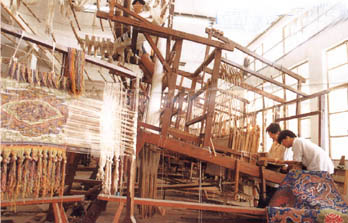 Brocade production
Brocade production

An inch of the Nanjing brocade was said to be as valuable as an ounce of gold. What is interesting is that the delicate and soft brocade came out from wooden looms as big as 5.6-meters long, 4-meters high and 1.4-meters wide. The huge looms needed two operators, one above and one below in the delicate production sequence that was as complicated as a current computer programming language. The process showed the incredible talent of Chinese of the past.
The person sitting at the loom was known as a "thread puller". All he or she had to do was to pull the thread in line in the threading sequence, corresponding to commands entered into a computer keyboard of today. The person sitting on the lower part of the loom was called a "weaver". He or she twined the pattern and wove the materials into brocade using golden or multicolored threads. The woven piece in front of the weaver was just like a computer screen. The weaving technology of the brocade is exceedingly complex and exquisite, and no modern machine has yet been able to replace the ancient looms.
There are mainly four categories in brocade: gold weaving, (in which gold is pressed into foil, then cut into thread-like pieces to be twisted into threads and then woven on looms) Ku Silk Fabrics, Ku Brocade Fabrics and Zhuanghua Silk Fabrics. All four categories serve as materials for emperors' robes, queens' dresses and shawls, concubine's clothing, decorations for the imperial courts and daily use articles, including cushions, mattresses, pillows, and quilts. The Nanjing brocade served as precious gifts for emperors to give to foreign kings and ministers.
